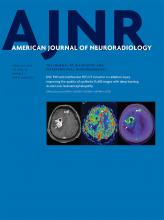Research ArticleAdult Brain
FDG-PET and MRI in the Evolution of New-Onset Refractory Status Epilepticus
T. Strohm, C. Steriade, G. Wu, S. Hantus, A. Rae-Grant and M. Larvie
American Journal of Neuroradiology February 2019, 40 (2) 238-244; DOI: https://doi.org/10.3174/ajnr.A5929
T. Strohm
aFrom the Department of Neurology (T.S.), Neurovascular Stroke Center, Ohio State University, Columbus, Ohio
C. Steriade
bDepartment of Epilepsy (C.S., S.H.)
G. Wu
cDepartment of Nuclear Medicine (G.W., M.L.)
S. Hantus
bDepartment of Epilepsy (C.S., S.H.)
A. Rae-Grant
eDepartment of Neuroimmunology (A.R.-G.), Cleveland Clinic, Cleveland, Ohio.
M. Larvie
cDepartment of Nuclear Medicine (G.W., M.L.)
dDepartment of Neuroradiology (M.L.)

References
- 1.↵
- 2.↵
- 3.↵
- 4.↵
- 5.↵
- Sakuma H,
- Awaya Y,
- Shiomi M, et al
- 6.↵
- 7.↵
- 8.↵
- 9.↵
- Iizuka T,
- Kanazawa N,
- Kaneko J, et al
- 10.↵
- 11.↵
- 12.↵
- 13.↵
- Leypoldt F,
- Buchert R,
- Kleiter I, et al
- 14.↵
- 15.↵
- 16.↵
- 17.↵
- 18.↵
- 19.↵
- 20.↵
- 21.↵
- 22.↵
- 23.↵
- 24.↵
- Khan NL,
- Jeffree MA,
- Good C, et al
- 25.↵
- Vincent A,
- Bien CG,
- Irani SR, et al
- 26.↵
- Maeder-Ingvar M,
- Prior JO,
- Irani SR, et al
- 27.↵
- 28.↵
- 29.↵
- 30.↵
- Mazzuca M,
- Jambaque I,
- Hertz-Pannier L, et al
- 31.↵
- 32.↵
- 33.↵
- Solnes LB,
- Jones KM,
- Rowe SP, et al
- 34.↵
In this issue
American Journal of Neuroradiology
Vol. 40, Issue 2
1 Feb 2019
Advertisement
T. Strohm, C. Steriade, G. Wu, S. Hantus, A. Rae-Grant, M. Larvie
FDG-PET and MRI in the Evolution of New-Onset Refractory Status Epilepticus
American Journal of Neuroradiology Feb 2019, 40 (2) 238-244; DOI: 10.3174/ajnr.A5929
0 Responses
Jump to section
Related Articles
Cited By...
- No citing articles found.
This article has been cited by the following articles in journals that are participating in Crossref Cited-by Linking.
- Manon Bordonne, Mohammad B. Chawki, Matthieu Doyen, Aurelie Kas, Eric Guedj, Louise Tyvaert, Antoine VergerEuropean Journal of Nuclear Medicine and Molecular Imaging 2021 48 12
- Thahesh Tharmaraja, Jamie Sin Ying Ho, Aidan Neligan, Sanjeev RajakulendranEpilepsia 2023 64 5
- Hyo Jae Kim, Sang‐Ahm Lee, Hyun‐Woo Kim, Soo Jeong Kim, Sang‐Beom Jeon, Yong Seo KooEpilepsia 2020 61 8
- Nadya Pyatigorskaya, Marie-Odile Habert, Laura RozenblumCurrent Opinion in Neurology 2020 33 4
- Chongyang Tang, Peng Ren, Kaiqiang Ma, Siyang Li, Xiongfei Wang, Yuguang Guan, Jian Zhou, Tianfu Li, Xia Liang, Guoming LuanNeuroImage: Clinical 2022 33
- Aikaterini Fitsiori, Shivaprakash Basavanthaiah Hiremath, José Boto, Valentina Garibotto, Maria Isabel VargasChildren 2019 6 3
- Functional outcomes of patients with NORSE and FIRES treated with immunotherapy: A systematic reviewP. Cabezudo-García, N. Mena-Vázquez, N.L. Ciano-Petersen, B. Oliver-Martos, P.J. Serrano-CastroNeurología (English Edition) 2024 39 8
- Ali Kassab, Dènahin Hinnoutondji Toffa, Manon Robert, Frédéric Lesage, Ke Peng, Dang Khoa NguyenNeuroImage: Clinical 2021 32
- Chenpeng Zhang, Yong Hao, Gan Huang, Mei Xin, Shuwei Bai, Yangtai Guan, Jianjun LiuCNS Neuroscience & Therapeutics 2023 29 6
- Konrad Rejdak, Agata Pikulicka, Małgorzata Piekarska, Katarzyna Pacek, Kamila PłachtaCurrent Neuropharmacology 2023 21 3
More in this TOC Section
Similar Articles
Advertisement











